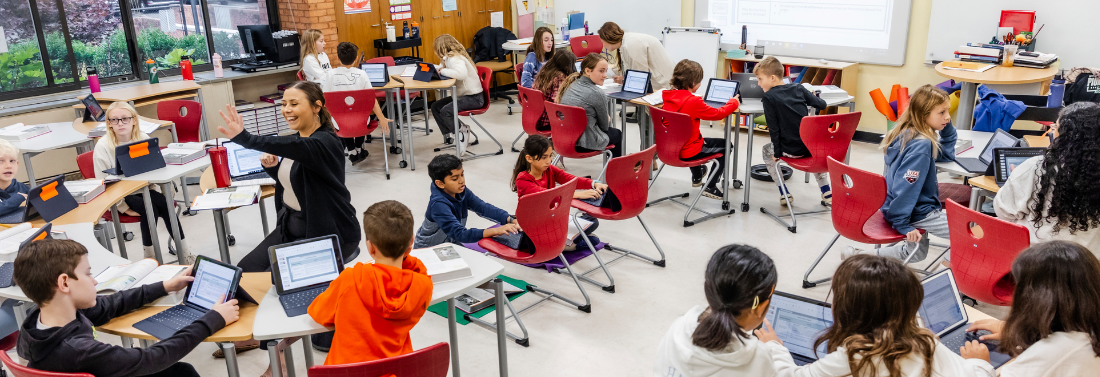Executive Summary:
New Providence Elementary Schools wanted to ensure their classrooms were future-ready. In Vivi, they found a wireless screen mirroring solution that untethered their teachers from the front of the classroom and supported touchback functionality without adding complexity for teachers. With Vivi, classrooms are more engaging and interactive.
Introduction
New Providence Elementary Schools in New Jersey are taking classroom engagement to the next level with the adoption of Vivi to facilitate wireless screen mirroring. Julie Spoerl, the Elementary Technology Coordinator, is actively involved in this project, working closely with the district’s leadership to seamlessly integrate this technology into the classrooms and encourage teacher adoption. This initiative aims to transform the classroom experience by enhancing inclusivity and interactivity, highlighting the district’s dedication to creating environments that improve learning for all students.
Background
Before Vivi, New Providence Elementary Schools had wired technology that limited teacher movement. Classrooms featured stationary desktops connected to interactive boards or projectors at the front, which confined teachers to one spot and hindered interactive learning. District administrators recognized these limitations, pointing out that the existing setup required a redesign to meet the district’s aim for future-ready classrooms. The objective was to develop more adaptable and engaging learning spaces to better serve contemporary educational demands.
Challenges
Vivi technology at New Providence Elementary Schools was selected to address several significant challenges to dynamic teaching and learning:
- Limited teacher mobility: The previous setup with stationary desktops connected to interactive boards significantly restricted teacher movement. Spoerl expressed the limitation this posed, “Before Vivi, we had desktops in every classroom that were tethered to either the interactive board or the interactive projector, and so teachers had to stand at that one spot.”
- Inconsistent interactive capabilities: Not all classrooms could fully utilize interactive features, especially the crucial touchback functionality. Spoerl pointed out the gap in technology compatibility: “We were seeking a technology that supported touchback functionality. However, not every wireless screen mirroring device we tested was capable of this feature.”
- Transition challenges: It was essential for the new technology to support existing teaching methods during the transition phase to ensure continuity in teaching quality. Spoerl highlighted this need, stating, “During the transition, it was crucial that teachers could continue to teach as before. We didn’t want them to start the school year unable to write on their boards or interact with them like they used to.”
These challenges highlighted the need for a more adaptable and universally applicable solution to support a variety of teaching styles and classroom environments.
Discovering Vivi
New Providence leaders first learned of Vivi at TechSpo, an educational technology conference in New Jersey. The team was drawn to Vivi for its potential to directly address the pre-existing challenges related to limited teacher mobility and inconsistent technological capabilities across classrooms. The conference marked the beginning of a significant technological transition for the district.
Once New Providence chose Vivi, the district began a comprehensive process to integrate this technology across its classrooms.
- Strategic decision-making: The decision to implement Vivi was influenced by its ability to offer universal compatibility with existing classroom hardware and to support interactive features essential for modern teaching methods.
- Testing and adoption: Before full integration, various technologies were tested to ensure compatibility and functionality, with Vivi standing out due to its unique features that supported teacher mobility and interactive teaching. Staff then visited other school districts already using Vivi to see it in action.
The initial phase laid the foundation for a comprehensive rollout, aiming to improve classroom technology and enhance interactive teaching.
Outcomes and benefits
Vivi’s deployment has resulted in a number of improvements:
- Enhanced teacher mobility: Vivis’ wireless screen sharing has freed teachers from the front of the classroom. Spoerl highlights this flexibility, noting, “The advantage to the Vivi is a teacher can walk into any classroom and know this is how you’re going to share your screen.” This mobility gives teachers the ability to interact with students more effectively and increases student-to-teacher interactions.
- Universal compatibility: Because Vivi works with just about any device and operating system, it can be used regardless of the specific hardware setup in a classroom. Indeed, regardless of setup, the experience is seamless for teachers. Spoerl values this feature, remarking, “I like the fact that we have different interactive displays in each classroom.”
- Simplified technology integration: Vivi’s user-friendly interface and reliable performance have made it easier for teachers to incorporate technology into their teaching methods, reducing the complexity and enhancing the usability of digital tools in the classroom. The experience of screen sharing is the same in every classroom.
- Dynamic learning environments: With the flexibility of Vivi, classrooms are more interactive and engaging. Student participation is increasing as teachers can adapt their teaching to meet the needs of their students.
These advancements have not only resolved the district’s initial technological challenges but also propelled New Providence Elementary Schools towards a more interactive and effective educational model.

Live video announcements and school-wide communication
A standout feature of Vivi that has enhanced the sense of community at New Providence Elementary Schools is its ability to facilitate live video announcements across all classrooms. Spoerl shared, “My favorite feature is the ability to broadcast across the rooms. We use this for our Monday morning announcements. It’s a fantastic way to start the week, as it really lifts everyone’s spirits on a Monday morning.” This feature centralizes communications and fosters a positive, cohesive school culture.
Additionally, the broadcast capability can be used for important messages and emergency notifications, ensuring timely and consistent information. This versatility demonstrates Vivi’s value beyond daily classroom activities.
Implementation process
To ensure adoption, the team at New Providence Elementary Schools took a thoughtful approach to piloting, training, and ultimately integrating the technology across various classrooms:
- Pilot program: Initially, Vivi was introduced in a select few classrooms to gauge its effectiveness and ease of integration. Spoerl mentioned the early stages, “We began piloting Vivi last year, starting with around six classrooms in each school and gradually expanding to about ten.”
- Training and support: Recognizing the importance of proper training, the district organized comprehensive training sessions to familiarize teachers with Vivi. Spoerl highlighted the importance of these sessions, stating, “Before the school year started, every teacher was required to attend a training session during the three professional development days. We organized these sessions to rotate through the three schools, ensuring all staff were trained on how to use Vivi.”
- Addressing challenges: To address potential resistance and technical issues, the district specifically involved teachers who were initially skeptical of the changes. Spoerl emphasized the value of involving diverse perspectives in the training process: “Sometimes you have naysayers. I make it a point to involve them in the process because it makes them more likely to assist “
- Ongoing support and advanced training: After the initial training, additional optional advanced training sessions were provided to deepen the teachers’ understanding of Vivi’s features. Spoerl noted, “We also held a second optional advanced training session before the school year began, where teachers could learn additional features of Vivi, with video playback being a major focus.”
This structured approach to implementation ensured teachers felt supported and were prepared to use the new technology effectively. It also fostered a positive attitude towards the change, easing Vivi’s successful integration into daily teaching activities.
Vision for the future
Looking ahead, New Providence Elementary Schools are set to further expand the capabilities of Vivi, building on the successful integration to enhance their educational systems. Spoerl’s enthusiasm for the potential applications of Vivi reflects a broad vision for its use, from facilitating district-wide communications to enriching interactive classroom activities. This progression signifies a commitment to leveraging technology not just for incremental improvements but for transformative educational experiences, setting a forward-thinking standard for how technology can enhance teaching and learning in dynamic and innovative ways.


